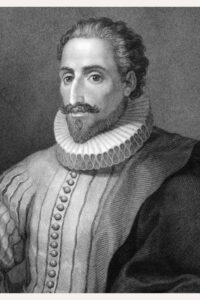
Don Quixote
In a metafictional narrative, Cervantes writes that the first chapters were taken from “the archives of La Mancha”, and the rest were translated from an Arabic text by the Moorish historian Cide Hamete Benengeli. Alonso Quixano is a hidalgo nearing 50 years of age who lives in La Mancha with his niece and housekeeper. While he lives a frugal life, as an avid reader of chivalric romances, he is full of fantasies about chivalry. Eventually, he goes mad and decides to become a knight errant. To that end, he dons an old suit of armour, renames himself “Don Quixote”, names his old workhorse “Rocinante”, and designates Aldonza Lorenzo (a slaughterhouse worker with a famed hand for salting pork) his lady love, renaming her Dulcinea del Toboso. As he travels in search of adventure, he arrives at an inn that he believes to be a castle, calls the prostitutes he meets there “ladies”, and demands that the innkeeper, whom he takes to be the lord of the castle, dub him a knight.
The innkeeper agrees. Quixote starts the night holding vigil at the inn’s horse trough, which Quixote imagines to be a chapel. He then fights with muleteers who try to remove his armour from the horse trough so that they can water their mules. In a pretended ceremony, the innkeeper dubs him a knight to be rid of him and sends him on his way. Quixote encounters a servant named Andres, who is tied to a tree and beaten by his master over disputed wages. Quixote orders the master to stop beating Andres and untie him, and the master swears to treat Andres fairly. However, the beating is resumed and redoubled as soon as Quixote leaves. Quixote then encounters traders from Toledo. He challenges them to agree that Dulcinea del Toboso is the most beautiful woman in the world. One of them demands to see her picture to decide for himself. Enraged, Quixote charges at them, but his horse stumbles, causing him to fall. One of the traders beats up Quixote, who is left at the side of the road until a neighbouring peasant brings him back home. While Quixote lies unconscious in his bed, his niece, the housekeeper, the parish curate, and the local barber burn most of his chivalric and other books. They seal up the room that contains the library, later telling Quixote that it was done by a wizard.
Read or download Book
Miguel de Cervantes
Miguel de Cervantes Saavedra (29 September 1547 (assumed) – 22 April 1616 NS) was an Early Modern Spanish writer widely regarded as the most excellent writer in the Spanish language and one of the world’s pre-eminent novelists.
Biography
He is best known for his novel Don Quixote, a work often cited as both the first modern novel and “the first great novel of world literature”. A 2002 poll of around 100 well-known authors[b] voted it the “most meaningful book of all time” from among the “best and most central works in world literature”.Much of his life was spent in poverty and obscurity, which led to many of his early works being lost. Despite this, his influence and literary contribution are reflected by the fact that Spanish is often called “the language of Cervantes”. An incident in the Don Quixote (1870) story by Robert Hillingford. In 1569, Cervantes was forced to leave Spain and move to Rome, where he worked in the household of a cardinal.
In 1570, he enlisted in a Spanish Navy infantry regiment and was severely wounded at the Battle of Lepanto in October 1571. He lost the use of his left arm and hand. He served as a soldier until 1575, when he was captured by Barbary pirates; after five years in captivity, he was ransomed and returned to Madrid.
His first significant novel, La Galatea, was published in 1585, but he continued working as a purchasing agent and later as a government tax collector. Part One of Don Quixote was published in 1605, and Part Two in 1615. Other works include the 12 Novelas ejemplares (Exemplary Novels); a long poem, the Viaje del Parnaso (Journey to Parnassus); and Ocho comedias y ocho entremeses (Eight Plays and Eight Interludes). Los trabajos de Persiles y Sigismunda (The Travails of Persiles and Sigismunda) was published posthumously in 1616. Santa María la Mayor, in Alcalá de Henares, where Cervantes was reputedly baptized; the square in front is Plaza Cervantes. Despite his subsequent renown, much of Cervantes’s life is uncertain, including his name, background, and what he looked like. Although he signed himself Cervantes, his printers used Cervantes, which became the standard form. In later life, Cervantes used Saavedra, the name of a distant relative, rather than the more usual Cortinas, after his mother.
However, historian Luce López-Baralt claimed that it comes from the word Shailendra in the Arabic dialect, which means “one-handed”, his nickname during captivity. Another area of dispute is his religious background. It has been suggested that Cervantes’s father and his mother may have been New Christians. Anthony Cascardi writes, “While the family might have had some claim to nobility, they often found themselves in financial straits. Moreover, they may have been of converso origin, that is, converts to Catholicism of Jewish ancestry. In the Spain of Cervantes’s days, this meant living under clouds of official suspicion and social mistrust, with far more limited opportunities than were enjoyed by members of the ‘Old Christian’ caste.” It is generally accepted Miguel de Cervantes was born around 29 September 1547 in Alcalá de Henares. He was the second son of barber-surgeon Rodrigo de Cervantes and his wife, Leonor de Cortinas (c. 1520–1593). Rodrigo came from Córdoba, Andalusia, where his father, Juan de Cervantes, was an influential lawyer.






